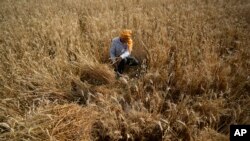An unusually early heat wave in India has likely reduced the country’s wheat harvest. That has left observers doubting that the country can meet its own needs while increasing crop exports to replace shortages caused by Russia’s war in Ukraine.
Recently, several large areas near India’s capital New Delhi which are used for waste storage have caught fire. The fires were blamed on the heat. Schools in eastern India shut down because of the heat. In the city of Rajgarh in central India, temperatures reached a record high 46.5 degrees Celsius. Temperatures reached 45 degrees Celsius in nine other cities.
But it was the heat in March that hurt crops. Wheat is easily affected by heat. Indian farmers time their planting so that the wheat ripens during India’s cooler spring.
But climate change has made India’s temperatures rise, said Friederike Otto. She is a climate scientist at the Imperial College of London. She said that before human activity increased world temperatures, heat waves like this year’s would have struck India once in 50 years.
“But now it is a much more common event — we can expect such high temperatures about once in every four years,” she said.
India’s vulnerability to extreme heat increased 15 percent from 1990 to 2019. That information comes from a 2021 report by the British medical publication Lancet.
India is among the top five countries where vulnerable people, like the old and the poor, have the highest exposure to heat. India and Brazil have the highest number of heat-related deaths in the world, the report said.
Farm workers like Baldev Singh are among the most vulnerable. Singh is a farmer in northern India’s Punjab state. He watched his crop dry up before his eyes as a usually cool spring changed to extreme heat. He lost about one-fifth of his crop.
“I am afraid the worst is yet to come,” Singh said.
Punjab is usually the biggest supplier to India’s national crop reserves. The government had hoped to buy about one-third of this year’s production from the area. But government officials predict lower production numbers this year. Agriculture policy expert Devinder Sharma said he expected to get 25 percent less wheat.
The same is true in other major wheat-producing states like Uttar Pradesh and Madhya Pradesh.
The Indian government purchased over 43 million metric tons of wheat in 2021. Sharma estimates it will instead get 20 to 50 percent less.
India is the world’s second-largest producer of wheat. But the country exports only a small percentage of its harvest. India had been hoping to gain from the worldwide disruption of wheat supplies by Russia’s war in Ukraine. Officials also want to develop new markets for Indian wheat in Europe, Africa, and Asia.
India needs about 25 million tons of wheat for the large food welfare program that usually feeds more than 80 million people.
Before the coronavirus, India had far more supplies than it needed. But Sharma said those reserves have been strained by the food welfare program. Officials provided free grain during the pandemic to about 800 million people.
The program was extended until September. But it is unclear if the program will continue beyond that time.
I’m Jonathan Evans.
Aniruddha Ghosal reported on this story for the Associated Press. Jonathan Evans adapted this story for Learning English.
Words in This Story
ripen –v. (agriculture) to become ready to use or eat
vulnerability –n. a weakness that leaves a person or group open to harm or damage
disruption –n. something that prevents or delays normal activities
welfare –n. a government program for poor or unemployed people that provides food, housing or medical care
strain –v. to push, press or to test the ability of something to continue









